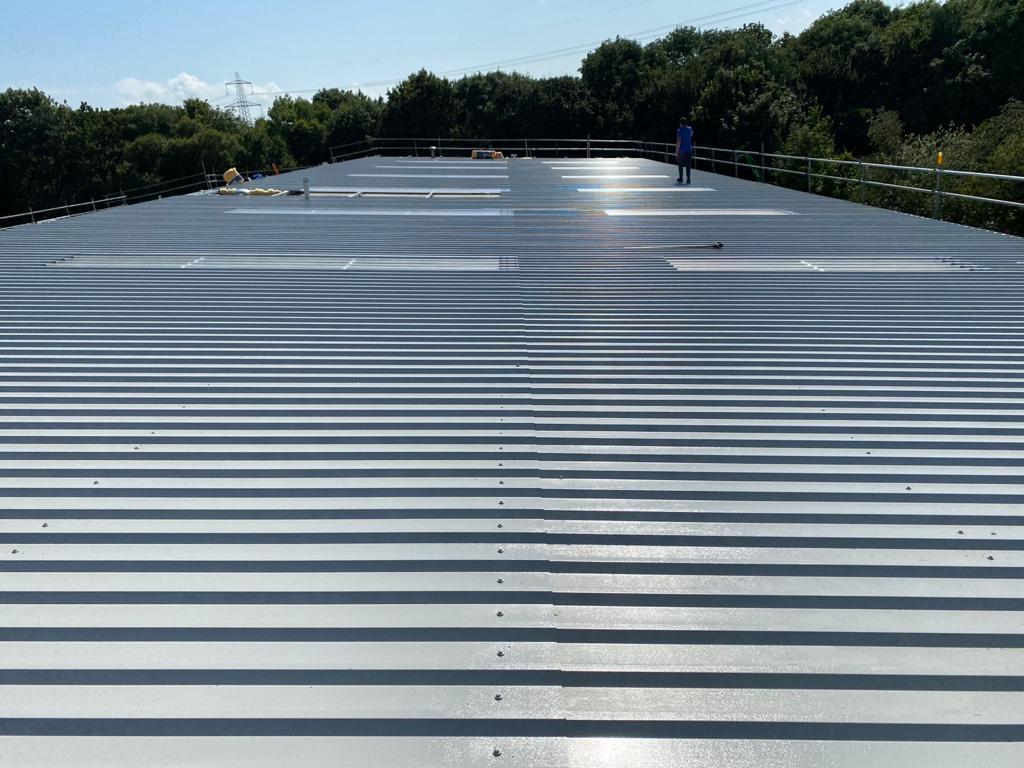Few things are more disruptive than a leaking roof, especially for industry and small industrial businesses. However, water intrusion doesn’t just inconvenience business owners and business operators – it can lead to costly damage, mold growth and long-term structural issues.
What Is a Roof Flashing?
Roof flashing describes a roofing process that acts as a protective layer installed at vulnerable points on a roof (particularly around joints and penetrations like chimneys, skylights or vent pipes). These areas are naturally more prone to leaks because they involve breaks or discontinuities in the roofing material.
Flashing acts as a seal, directing water safely away before it can seep inside.
Though flashings can be made from various materials, metal is generally preferred for its strength and weather resistance. It’s also flexible enough to be shaped around corners and edges – while remaining tough enough to withstand wind, rain and heavy sun exposure.
How Flashing Works
Metal flashing comes in thin, durable sheets that are strategically placed at intersections or terminations in the roofing structure. You’ll typically find it around roof features like chimneys, skylights, dormers and valleys. Anywhere the roof surface changes or is punctured basically.
Without flashing, sealing these joints becomes nearly impossible, especially as they expand and contract with temperature and humidity changes. Our team are fully experienced rain or shine, throughout Dorset, so have no issues with the changes that flashing will present to the installer.
Flashing accommodates these movements while maintaining a watertight seal. It uses surface tension and wind pressure to divert water away from potential entry points.
We utilise several installation techniques depending on the roof’s design. In some cases, flashing pieces overlap each other; in others, they’re bent or shaped to interrupt surface tension, so water doesn’t track underneath.
Why Flashing Is Essential
Historically, builders tried various methods to divert water from roof penetrations—angling shingles away from joints, placing chimneys along ridgelines, or stepping masonry to throw off rain. While innovative, these solutions often fell short, leading to drafty and leaky buildings.
Flashing was introduced to address these shortcomings. When properly installed it not only prevents leaks, but also stops moisture ingress that can lead to mold growth and reduced energy efficiency. It’s now a fundamental part of any weatherproof industrial roofing system.
Features like vent pipes, chimneys, roof valleys, and even door and window openings benefit from flashing systems. By sealing out water and resisting air movement, flashing improves a building’s structural integrity and lifespan.
Common Flashing Materials
Flashing can be fabricated from several materials—both metallic and non-metallic:
- Metal options include aluminium, copper, lead, zinc, lead-coated copper, and stainless steel. These are favoured for their longevity and resistance to the elements.
- Non-metallic options include plastic and rubberised asphalt. These are sometimes used in less exposed areas but are generally less durable, especially under direct sunlight or in extreme temperatures.
Most visible flashing installations use metal, though some are concealed beneath roof coverings for aesthetic or structural reasons.
Types of Roof Flashing
The type of flashing required depends on where it’s being used. Each type is tailored to a specific purpose:
Roof Flashing
Roof flashing is typically installed at general discontinuities across a roofing system, such as roof edges. Its main function is to channel water away from these vulnerable areas so as to prevent leaks and water ingress. It plays a crucial role in protecting industrial roof structures during heavy rainfall and is especially critical in areas with consistent exposure to wind-driven rain. Properly installed roof flashing ensures the longevity of the roof by sealing potential weak points where water might otherwise penetrate and cause damage to insulation, timber framing and internal ceilings/walls.
Roof Penetration Flashing
Wherever structural elements or services penetrate through the roof surface. This includes pipes, conduit cables, HVAC supports, satellite mounts and all other utilities that create holes in the roofing membrane. These points are highly vulnerable to water ingress without the right protection. Penetration flashing is precisely shaped and sealed to prevent leaks while allowing for some movement from temperature changes or structural settling. Effective roof penetration flashing is essential to maintaining waterproof integrity and is often paired with sealants or boot fittings for an added layer of protection around the opening.
Channel Flashing
Channel flashing, shaped like a “U”, is installed where the industrial roof meets a vertical surface such as a wall. Its main role is to collect and redirect water that runs down the wall or roof slope, guiding it safely away from the joint. This type of flashing is particularly useful in managing large volumes of water in areas prone to runoff accumulation. Channel flashing is a pro-active way to prevent water pooling and seepage at wall-roof interfaces (where water can otherwise settle and infiltrate the building). It’s essential for preserving the structural integrity of adjoining surfaces.
Valley Flashing
Used in the troughs where two roof planes meet to form a valley (often one of the most water-exposed areas on a roof). Rainwater naturally collects and accelerates in these valleys, making them especially prone to leakage if not properly protected. Valley flashing provides a durable channel that guides water down and off the roof without allowing it to seep under shingles or tiles. Available in pre-bent metal forms, valley flashing must be securely fitted and layered beneath surrounding roof materials to ensure water remains on the surface and flows efficiently to the gutters.
Step Flashing
Designed for use where a sloped roof meets a vertical wall, such as at the base of a dormer or along chimney sides. It consists of individual metal pieces layered in a shingle-like fashion, with each piece overlapping the one below. This installation method allows for effective water drainage and accounts for the expansion and contraction of materials. Step flashing is especially important in preventing water from creeping behind siding or wall cladding. It integrates seamlessly with roof shingles and is often used in conjunction with counter flashing for enhanced moisture protection in vertical junctions.
Counter Flashing
Counter flashing is installed above or in conjunction with base or step flashing. Its primary function is to shield the lower flashing layers from the elements and stop water from infiltrating behind them. Often embedded into masonry or stucco, counter flashing acts as an upper seal, directing water away from the structure. It is particularly common around chimneys and other vertical penetrations. By overlapping the base flashing, it creates a layered defence that ensures rainwater doesn’t get trapped or bypass the initial flashing barrier. This two-part flashing system provides reliable, long-term protection for high-risk joints.
Wall Flashing and Pipe Flashing
Wall flashing is applied to vertical walls that intersect the roof, helping to seal the joint and prevent water penetration where the roofline meets external walls. It is vital in protecting against water seepage behind siding or cladding. Pipe flashing, on the other hand, is specifically tailored for sealing around round roof penetrations such as vent pipes and flues. These flashings are designed to be flexible and weather-resistant, accommodating movement and expansion. Both types are essential in maintaining a building’s waterproof envelope and are key to preventing interior damage caused by undetected moisture ingress.
Flashing Design and Best Practices
Choosing the right material is only part of the equation. Installation must also take into account chemical compatibility between flashing and adjacent materials. For example, galvanic corrosion can occur when certain metals come into contact shortening the lifespan of your flashing and potentially compromising your roof.
Aluminium remains one of the most reliable flashing materials available today. It’s highly resistant to corrosion, cost-effective, and easy to shape, making it ideal for bespoke flashing profiles. When installed correctly, aluminium flashing offers long-term protection and peace of mind.
Industrial Flashing Installer Throughout Dorset and Hampshire
In roofing, prevention is always better than cure and flashing is a crucial part of that strategy. By sealing joints and diverting water, the system works by accommodating structural movement. Metal flashing not only protects against leaks but also ensures the durability and energy efficiency of your building. It’s a small detail that plays a big role in keeping the elements out and your industrial business safe.
Why Choose Finn Industrial Roofing
If you’re looking for expert industrial solutions, backed by experience and reliability, , look no further than Finn Industrial Roofing. With over two decades of hands-on experience in the industry, we have built a strong team and specialise in providing durable, precision-installed metal flashing systems across Dorset
Whether you’re planning new industrial roof construction or repairs to your existing roof, our team of highly trained professionals is ready to help. Our commitment to craftsmanship and client satisfaction ensures your roof remains watertight, secure and energy efficient.














